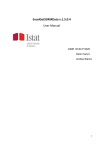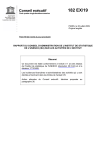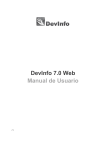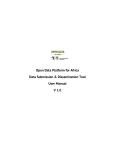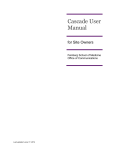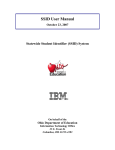Download OECD.Stat Web Browser User Guide
Transcript
OECD.Stat Web Browser User Guide 2013 OECD.Stat Web Browser User Guide May 2013 May 2013 1 OECD.Stat Web Browser p.10 Search by keyword across themes and datasets User Guide 2013 p.11 Customise dimensions: p.31 View and save combined queries p.9 Collapsible theme panel with expandable list of themes and datasets select variables, change table layout; view table options p.21 Export data to Excel/CSV/SDMX p.8 Full-text p.30 Save and manage queries search tool p.26 Draw a chart using the current data selection Collapsible metadata p.28 panel http://stats.oecd.org May 2013 2 OECD.Stat Web Browser User Guide 2013 Table of Contents: Introduction............................................................................................................... 4 OECD.Stat Concepts........................................................................................................................... 4 Data Organisation.............................................................................................................................. 4 Reference Series................................................................................................................................ 5 User Guide.................................................................................................................. 6 Getting Started Page................................................................................................................ 6 Language Selection....................................................................................................................7 Locating Data through the OECD.Stat Search .......................................................................... 8 Locating Data by Browsing Themes ......................................................................................... 9 Locating a Dataset or a Query in the Theme List ..................................................................... 10 Using the Table Features ........................................................................................................ 11 Selecting Dimensions and their Variables ..........................................................................................12 Changing Time and Frequency ..........................................................................................................14 Adjusting the Dataset View by Moving Dimensions..............................................................................16 Formatting Options...........................................................................................................................18 Exporting to Excel ............................................................................................................................21 Exporting to a CSV file .....................................................................................................................22 Downloading related files and large data selections ...........................................................................23 Exporting to PC-Axis Table................................................................................................................24 Exporting to an SDMX file................................................................................................................. 25 Charting Data ..................................................................................................................................26 Viewing Metadata....................................................................................................................28 Other Related Metadata.........................................................................................................................28 Flags ...............................................................................................................................................29 Working with Queries ............................................................................................................ 30 Saving a Query ................................................................................................................................30 Combining Queries .................................................................................................................31 Combining Multiple Queries.............................................................................................................31 Viewing the Query..............................................................................................................................32 Changing the Query..........................................................................................................................32 Saving a Multi-Dataset Query.............................................................................................................32 Viewing Frequently Requested and Saved Queries ................................................................. 33 Viewing the Country Statistical Profiles ................................................................................. 35 Printing Data from the Browser ............................................................................................. 36 Providing Feedback ......................................................................................... 37 May 2013 3 OECD.Stat Web Browser User Guide 2013 Introduction OECD.Stat is the statistical online platform of the OECD where users can search and access OECD’s statistical databases. Working across and within individual datasets, you will be able to: • • • Build tables by selecting variables and customising the table layout Extract and download large volumes of data (up to 100,000 cells in Excel, and 1,000,000 in CSV format) View detailed metadata on methodology and sources OECD.Stat Concepts OECD.Stat is structured around these main concepts: • • • • Information catalogued by themes, datasets, dimensions, variables and reference series Storage of metadata ranging from the dataset to the cell level Storage of numeric data figures, as well as cell-level flags A data warehouse search engine Data Organisation Datasets Within OECD.Stat, statistical data are organised into datasets. A dataset is a collection of numerical values with associated textual information. All values share a common set of dimensions. Dimensions The dimensions of a dataset are the axes on which the data are labeled. Country and year are two common examples of dimensions. Dimensions can be presented as either a flat list or as a hierarchy with dimension subsets. Variables Every dimension contains a pre-defined list of variables. In the country dimension for example, the variables are the individual countries. Metadata Metadata is the qualitative data that describes the empirical data in OECD.Stat. Metadata can be viewed for datasets, dimensions and variables alongside the table. Flags A flag is a letter that appears alongside the numerical data in any table cell where it applies. It is a qualitative note that recurs in a dataset for many individual data figures. A legend appears beneath the table, explaining the meaning of each flag present in the table. Flags frequently indicate general data properties such as “confidential”, “provisional” and “estimated”. Query A query is a pre-defined set of data within a dataset to highlight a certain topical content of the overall dataset. Queries appear alongside of datasets May 2013 4 OECD.Stat Web Browser User Guide 2013 Reference Series A number of data series that the OECD Statistics Directorate uses to calculate indicators are available via the Reference Series dataset. Data in this dataset are linked dynamically to the source datasets from which they are taken so that there is no duplication of data and that the Reference Series contain the most recent data available. May 2013 5 OECD.Stat Web Browser User Guide 2013 User Guide This user guide walks you through basic and more advanced features of OECD.Stat. Getting Started Page The browser is best used in full-screen view at 1024x768 pixel screen resolution or higher. From the Welcome page, you may find data in the following ways: • Search OECD.Stat by Keyword • Browse Themes • Search Themes by Keyword Figure 1: OECD.Stat Browser Welcome Page May 2013 6 OECD.Stat Web Browser User Guide 2013 Language Selection You can view the interface and data in English or French. To change the language, click on the language option located in the top right-hand corner of the screen. Figure 2: Changing the language of the browser May 2013 7 OECD.Stat Web Browser User Guide 2013 Locating Data through the OECD.Stat Search Enter keywords in the OECD.Stat Search box in the top right-hand corner of the screen. OECD.Stat will search through dataset names, dimension names, variable names, and metadata for the keywords you entered. You will get a list of search results, which includes a link to the dataset where the keywords were found, and details of where the keywords appear in the dataset. To open a dataset, click on the link. NOTE: Once you click on a link, you are not be able to navigate back to the search results. Run the search again if you want to click on another link. The most relevant links are shown first, based on how often the keyword appears in each dataset. A keyword in the name of a dataset is considered more relevant than a keyword found only in one of the variables of a dimension in the dataset or in the metadata. Figure 3: Results from the search ranked in order of relevance May 2013 8 OECD.Stat Web Browser User Guide 2013 Locating Data by Browsing Themes Browse the Data by Theme panel by clicking on a theme title, then on a sub-theme title and so forth until you can select a dataset. Datasets are marked by the table icon in front of their name. When you click on a dataset, a default table view opens. This view can be customised (see next section). Figure 4: Browsing through themes to view data May 2013 9 OECD.Stat Web Browser User Guide 2013 Locating a Dataset or a Query in the Theme List Search across themes and datasets by entering a keyword in the text box at the top of the Data by Theme panel. All dataset titles that contain the keyword are highlighted in yellow. To start over, simply click Reset to the right of the text entry box and enter a new keyword in the text entry box. Figure 5: Finding a theme or dataset by keyword This method also allows a quick lookup for well known OECD data sets by their acronym, e.g. MEI, STAN, ITCS, etc. May 2013 10 OECD.Stat Web Browser User Guide 2013 Using the Table Features When you first open a dataset, you see the default table view. Use the options at the top of the table to modify the default data selection. Figure 6: Default dataset view and current selection values Click on: • Customise - to select variables for each dimension and change the table layout and display options. • Export - to download and save your selection as a MS Excel, CSV, PC-Axis, or SDMX file. • Draw Chart - to dynamically graph the displayed data. • My Queries - to save the current table view as a personal query for further work. You need to log in first to take full advantage of all query features. May 2013 11 OECD.Stat Web Browser User Guide 2013 Selecting Dimensions and their Variables Select variables in each dimension by clicking on the Customise option at the top of the table and then the Selection option from the drop-down menu. Select variables from each dimension to be displayed in the table View sub-categories by clicking on the plus + or minus - symbol Figure 7: Customise the selection of variables for each dimension To select or unselect a variable, click the check box to the left of the variable. A plus (+) or minus (-) symbol appears next to the variable name if the variable has a sub-category. Click on this symbol to show or hide the variables of the sub-category. Click View Data to apply your selection of variables for the current dimension and to see a table corresponding to this new selection. Alternatively, after selecting variables for one dimension, continue modifying the other dimensions shown across the top of the pop-up screen before viewing the new table. May 2013 12 OECD.Stat Web Browser User Guide 2013 You may also search for variables in the Customise Selection pop-up by typing a keyword in the search box for a given dimension. All variables containing the keyword will be displayed. Enter keyword in the search box Search results containing the keyword are listed in the pop-up window Figure 8: Search variables by keyword when customising dimensions Customise Selection: Colour Coding Colour coding helps you see if data exist for a particular variable. This way, you will not waste time searching for data that does not exist. When modifying dimensions in the Customise Selection window, you see that variable names are different colours. The colours indicate whether data exist or not for a given variable. Based on the current selection for all other variables… Dark Blue: Data exist for this variable. Blue: No data exist for this variable, but may exist for sub-categories of this variable. Gray: No data exist at any level for this variable. Remember: The colour coding takes into account the current selection for all other variables. In other words, the colours indicate the existence of data for the countries, years, etc. currently selected. May 2013 13 OECD.Stat Web Browser User Guide 2013 Changing the Time/Period and Frequency There are two ways to select the time/period and frequency variables: • • Select the time range Select the time period Time Range Selection All frequencies available for the selected dataset are shown on the screen. For example, if only annual data are available, the option to select quarters and months will not appear. First check the boxes next to the frequencies to be included in the selection. Then choose either a specific range of dates (from 1980 to 2000, for example) by clicking Select Date Range, or indicate that you wish to have the most recent data available (last 5 years, for example) by clicking Select Latest Data. When selecting a date range, it is possible to select a start year, quarter, month, etc. and automatically include all available data from that date onward by checking the box next to Latest Available Data. Quarterly and monthly ranges are not available for all datasets Figure 9: Time range selection May 2013 14 OECD.Stat Web Browser User Guide 2013 Time Period Selection It is also possible to select individual years, quarters, months, etc. by checking the box next to each item. This is necessary if the selection of dates you wish to include is not a continuous series and contains breaks or time periods outside the main date range. Figure 10: Time period selection Note: It is advisable to first select a general range of dates using the Select Time Range option, and then include or exclude individual time periods using the Select Time Period option. Similarly, you may lose selected individual time periods if you make changes in the Select Time Period option before using the Select Time Range option. The Select Time Range option only manages continuous, non-broken series of dates. May 2013 15 OECD.Stat Web Browser User Guide 2013 Adjusting the Dataset View by Moving Dimensions The different dimensions of a dataset can be displayed on either the horizontal or vertical axis of a table, or in the filter area at the top of the table. To move a dimension from one place to another, click on the Customise option at the top of the table and then the Layout option from the drop-down menu. A dialog box pops up that allows you to visually drag and drop a dimension in the desired location. Select a dimension to drag and drop it in a different location Use these arrows to arrange dimensions within a Row, Column or Page/Filter Click these arrows to move selected dimensions to a different location Figure 11: Moving a dimension to change the data table layout May 2013 16 OECD.Stat Web Browser User Guide 2013 If there is more than one variable selected for a dimension located in the filter area at the top of the table, click on the variable to open a drop-down menu displaying all variables. To change the filter that is applied to the data, select the desired variable from the drop-down menu. If the dimension in the filter area does not have a drop-down menu, then only one variable has been selected. To include other variables, click on the dimension name to the left of the selected variable and check other desired variables in the pop-up box. Figure 12: Changing the view using Country drop-down list May 2013 17 OECD.Stat Web Browser User Guide 2013 Formatting Options To format the view of the displayed table, click on Customise above the table and then select Table options from the drop-down menu. From there you can customise table options: • Decimals: Select the number of decimal points displayed for the data points. • Scaling: Multiply the data points by unit value, hundreds, thousands, hundredths, thousandths, etc. • Dimension Member Labels: View dimension names as codes, descriptive titles or both. • Empty rows and columns: Hide or show rows and columns that contain no data. The option to Fully Fill Page only appears when Hide Empty Rows is selected. • Hierarchies: Hide row hierarchies and/or column hierarchies. • Other Options: Show empty axes, show timestamps of when the data was uploaded and/or show data bars to more easily visualize the data trends within each cell. Fully Fill Page only appears when Hide Empty Rows is selected Figure 13: Customising table options May 2013 18 OECD.Stat Web Browser User Guide 2013 Showing Codes Instead of Names All datasets, dimensions and variables have short codes as well as names. To display codes instead of names in the table, click on Customise above the table, select Table options from the drop-down menu and then select the option Use codes instead of Use full descriptions. To show both codes and full descriptions, select both Use codes and Use full descriptions. Figure 14: Table showing codes instead of names May 2013 19 OECD.Stat Web Browser User Guide 2013 Hiding Empty Rows or Columns If a table has many rows or columns containing no data, it can be useful to hide these rows or columns in order to condense the table and improve readability. To hide empty rows or columns, click on Customise above the table, select Table options from the dropdown menu and then select the option Hide empty rows, Hide empty columns, or both. Figure 15a: Before using the Hide Empty Rows and Columns options Figure 15b: Dataset view with empty rows and columns hidden May 2013 20 OECD.Stat Web Browser User Guide 2013 Exporting to Excel Click on the Export option above the table and then select Excel to export your data selection to a MS Excel file. You are prompted to either save the MS Excel file to disk or open it directly. As your computer settings may not allow for the file to be directly opened, it is recommended that you save the file to your desktop and then open it from there. The maximum size of the file is limited to 100,000 data points. Data flags saved as Excel footnotes Figure 16: Using the Export to Excel option to save data in Excel format May 2013 21 OECD.Stat Web Browser User Guide 2013 Exporting to a CSV file Larger tables can be saved to a CSV file. Click on the Export option above the table and then select Text file (CSV). The maximum size of the file is limited to 1,000,000 data points. Select a dimension label format and a column separator. The dimension label format determines what information is included in your file for each variable. The column separator determines which character is used to separate columns in the file. Enter your e-mail address and click the Export to Text (CSV) file button. An e-mail is sent to you informing you how to retrieve the CSV file. The file is not attached to the email as it may be very large. Instead, the e-mail contains a link for downloading the file. Enter your email address to receive the CSV file. Figure 17: Using the Export to CSV option to save data as a CSV file May 2013 22 OECD.Stat Web Browser User Guide 2013 Downloading related files and large data selections Documents related to a particular dataset are available for download under the Export option above the table. The list of files may contain large prepared selections of data or related documents in any format, which is indicated in the File type column. Click on the name of a file to download it. Figure 18: Finding and downloading files related to a dataset May 2013 23 OECD.Stat Web Browser User Guide 2013 Exporting to PC-Axis Table Click on the Export option above the table and then select PC-Axis to export your data selection to a PC-Axis table file. As your computer setting may not allow you to open the file directly, first save the file to your desktop and then open it. Figure 19: Exporting to PC-Axis table May 2013 24 OECD.Stat Web Browser User Guide 2013 Exporting to SDMX Click on the Export option above the table and then select SDMX to export your data selection to a XML file. The data is available in compact or generic SDMX XML data format. The structure of the dataset, including the variable codes and labels is available to export via the Data Structure Definition (DSD) file. You are prompted to either save the XML file to disk or open it directly. As your computer settings may not allow for the file to be directly opened, it is recommended that you save the file to your desktop and then open it from there. Refer to www.sdmx.org for more information. Note for developers: There is a prototype web service which uses the standard SDMX REST API for queries. The technical specification of the RESTful query syntax can be found in the SDMX 2.1 Technical Specification (Section 7 – Web Services Guidelines). You may copy and paste the query in from the SDMX Data URL into your own software program. In some cases, pre-authorisation for use of the web-service may be required, so please contact us (see page 37) if you have any questions. Figure 20: Exporting to SDMX May 2013 25 OECD.Stat Web Browser User Guide 2013 Charting A dynamic charting tool allows you to create line charts, bar charts and scatter plots using the current data selection. The charting engine is limited to work with 20 000 data points - limit the data selection in your table before creating a chart. The table dimension and variable selections are reflected in the chart you create. Play changes in the data over time at different speeds Click on the little arrow next to the Y-Axis variable to view the charting options panel. Charting Options Panel You can adjust the time span and the scale of the Y-Axis. You can view the data figures as absolute values or as percentage changes. NOTE: The options available in the charting options panel vary with the chart type eg. line chart, bar chart, scatter plot. Figure 21: Charting--Line Chart May 2013 26 OECD.Stat Web Browser User Guide 2013 Figure 22: Charting--Bar Chart Figure 23: Charting--Scatter Plot May 2013 27 OECD.Stat Web Browser User Guide 2013 Viewing Metadata Metadata can be viewed at all levels: from the dataset-level abstract down to cell-level footnotes. The presence of metadata is flagged by a small blue circle with a white “i”. Clicking on the i reveals an information panel on the right-hand side of the screen. When you export a table to an Excel file, the metadata link Click on the i to open the metadata panel on the right side of the screen i is still active in the Excel file. Hide the metadata panel for a full-screen view of the data table Scroll through the metadata panel Figure 24: Dataset and cell-level metadata Other Related Metadata The metadata panel may contain links to metadata for related datasets as well as contact information. May 2013 28 OECD.Stat Web Browser User Guide 2013 Flags Flags represent metadata that recurs frequently within a dataset. Flags appear as letters in parentheses in the cell alongside the data figures to which they correspond. Any table that contains flags displays a legend below the table that explains the meaning of each letter. Hover above the flag to learn what it means. Figure 25: Viewing the data flag legend May 2013 29 OECD.Stat Web Browser User Guide 2013 Working with Queries Saving a Query Before working with queries, log in by clicking on the Login link in the top right-hand corner of the screen. Once logged in, your name appears in the top right-hand corner of the screen. Your data selection, or query, can be saved at any time by clicking on the My queries option above the table and then selecting Save. In the pop-up box, type the name of the query, and then click the Save as new Query button. On subsequent visits to the browser, this saved query can be opened to view the latest data available within the selection. Name the query you want to save Save your query! Figure 26: Saving a query with optional renaming May 2013 30 OECD.Stat Web Browser User Guide 2013 Combining Queries Use the Combine Query function to view data from two or more datasets in a combined table. Any common dimensions between the different datasets should be automatically combined, provided that the data has been correctly entered into the system. Other dimensions will automatically be displayed along the vertical axis underneath section headings indicating which dataset they come from. Combining Multiple Queries First, customise a table from one dataset. Then click on the My queries option above the table and select the Combine option in order to put this query into your “data basket”. The data basket holds queries to be combined Figure 27: Adding a selection of data to a multi-dataset query Repeat this routine for each dataset that you wish to include in the multi-dataset query. May 2013 31 OECD.Stat Web Browser User Guide 2013 Viewing the Query When you are finished adding queries to the Combine Queries basket, expand the Combined Queries panel on the left-hand side of the screen and click View to see the combined data table. Save the combined query View the combined query Figure 28: Viewing combined queries May 2013 32 OECD.Stat Web Browser User Guide 2013 Viewing Frequently Requested and Saved Queries Open the Popular Queries panel to access a set of frequently requested pre-defined queries. If you are logged in, you may access and manage your saved queries under: My Queries in the Popular Queries panel OR Manage under My Queries above the table. Figure 29: Using the popular queries panel to select a frequently requested table or a saved table May 2013 33 OECD.Stat Web Browser User Guide 2013 Use the Query Manager to sort and save the list of queries, as well as to open or delete any query. Sort queries by typing the order number in the box next to the query name Figure 30: Viewing saved and recent queries Click the Share button next to a saved query to display the reference URL. Copy and paste the URL to share your saved query with colleagues, e.g. send via email. NOTE: Bear in mind that the viewer may need subscription access to a particular dataset in order to view it. Copy and paste the link to share your query Figure 31: Sharing saved queries May 2013 34 OECD.Stat Web Browser User Guide 2013 Viewing the Country Statistical Profiles The Country Statistical Profiles dataset is useful for cross-country comparisons based on key indicators compiled from all other datasets in OECD.Stat. Click on a pre-defined country or region table below the Country Statistical Profiles dataset in the Themes panel. Then customise the country table using the Customise option. Select the Country Statistical Profiles dataset to explore cross-country comparisons OR Select pre-defined tables for individual OECD and some non-OECD countries and regions Figure 32: Viewing a Country Statistical Profile May 2013 35 OECD.Stat Web Browser User Guide 2013 Printing Data from the Browser To print a table directly from OECD.Stat, right-click on the table and select the Print command. Print the metadata separately by clicking on the Print icon in the top right-hand corner of the metadata panel. Right-click to print table using the web browser print options. Click to print out displayed metadata. Figure 33: Printing data and other information from the web browser May 2013 36 OECD.Stat Web Browser User Guide 2013 Providing Feedback Contact the OECD.Stat Project Team via e-mail using the Contact Us link located in the top right-hand corner of the screen. Please fill out the contact form using as much detail as possible to describe your technical or content question. The e-mail addresses that receive queries from the Contact Us link are • • [email protected] for technical problems [email protected] for content questions Click here to contact the OECD.Stat support team Figure 34: Creating an e-mail to the OECD.Stat Project Team May 2013 37 OECD.Stat Web Browser User Guide 2013 Table of Figures used in this Guide: Figure 1: OECD.Stat Browser Welcome Page.......................................................................6 Figure 2: Changing the language of the browser..................................................................7 Figure 3: Results from the search ranked in order of relevance...............................................8 Figure 4: Browsing through themes to view data..................................................................9 Figure 5: Finding a theme or dataset by keyword.................................................................10 Figure 6: Default dataset view and current selection values.................................................11 Figure 7: Customise the selection of variables for each dimension........................................12 Figure 8: Search variables by keyword when customising dimensions...................................13 Figure 9: Time range selection........................................................................................14 Figure 10: Time period selection......................................................................................15 Figure 11: Moving a dimension to change the data table layout...........................................16 Figure 12: Changing the view using Country drop-down list................................................17 Figure 13: Customising table options................................................................................18 Figure 14: Table showing codes instead of names..............................................................19 Figure 15: Dataset view with empty rows and columns hidden.............................................20 Figure 16: Using the Export to Excel option to save data in Excel format...............................21 Figure 17: Using the Export to CSV option to save data as a CSV file....................................22 Figure 18: Finding and downloading files related to a dataset..............................................23 Figure 19: Exporting to PC-Axis table...............................................................................24 Figure 20: Exporting to SDMX.........................................................................................25 Figure 21: Charting--Line Chart.......................................................................................26 Figure 22: Charting--Bar Chart........................................................................................27 Figure 23: Charting--Scatter Plot.....................................................................................27 Figure 24: Dataset and cell-level metadata.......................................................................28 Figure 25: Viewing the data flag legend............................................................................29 Figure 26: Saving a query with optional renaming..............................................................30 Figure 27: Adding a selection of data to a multi-dataset query.............................................31 Figure 28: Viewing combined queries...............................................................................32 Figure 29: Using popular queries panel to select a frequently requested table or saved table...33 Figure 30: Viewing saved and recent queries.....................................................................34 Figure 31: Sharing saved queries.....................................................................................34 Figure 32: Viewing a Country Statistical Profile..................................................................35 Figure 33: Printing data and other information from the web browser...................................36 Figure 34: Creating an e-mail to the OECD.Stat Project Team.............................................37 May 2013 38 OECD.Stat Web Browser p.10 Search by keyword across themes and datasets User Guide 2013 p.11 Customise dimensions: p.31 View and save combined queries p.9 Collapsible theme panel with expandable list of themes and datasets select variables, change table layout; view table options p.21 Export data to Excel/CSV/SDMX p.8 Full-text p.30 Save and manage search tool queries p.26 Draw a chart using the current data selection Collapsible metadata p.28 panel http://stats.oecd.org May 2013 39








































